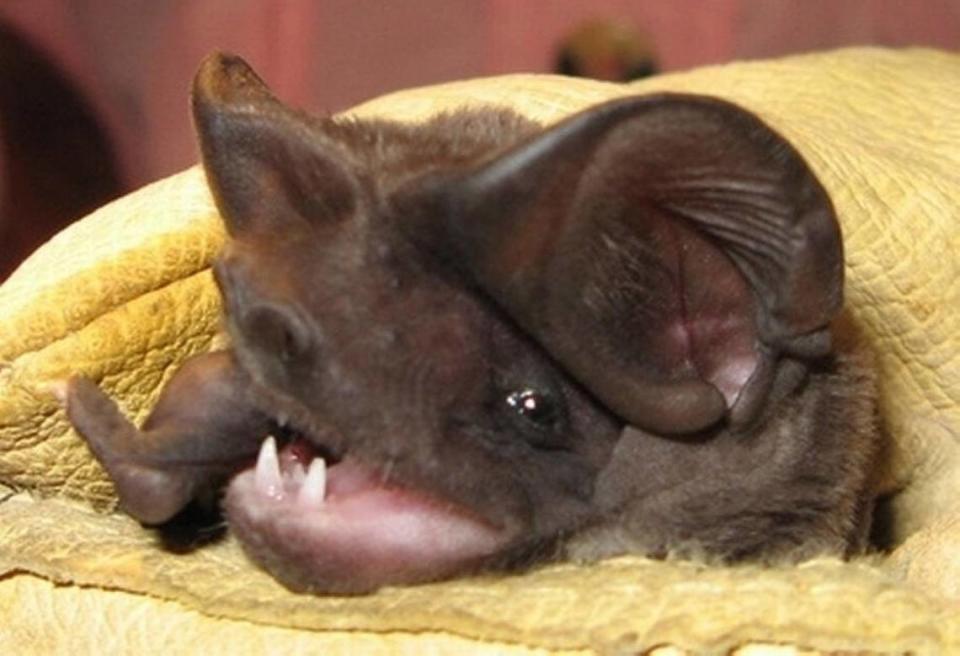A blue moon is making Halloween spooky even for the endangered Florida bonneted bat
This weekend, a full moon is making Halloween spookier not just for trick-or-treaters or voters suffering from election anxiety.
The rare Florida bonneted bats, among the most endangered mammals on the planet, might actually be scared of the full moon. They will probably avoid venturing too far out of bat boxes and other roosts around Miami-Dade this Halloween.
Like many species of bats, these trumpet-eared cuties hide during bright moonlit nights because that’s when they are the most visible to predators like owls and hawks.
“The bonneted bats won’t be exposing themselves too much this Halloween,” said Frank Ridgley, head of Zoo Miami’s conservation and research department. “They will probably stay close to their roosts or around the edge of forests.”

But that doesn’t mean that there isn’t drama in the lives of these endemic Miami-Dade inhabitants, Ridgley said. And this blue moon — the second full moon in October — is probably the least of their worries.
Bats’ home is disappearing in South Florida
Like other disappearing species in South Florida, the bonneted bats have seen their native habitat shrink dramatically over the past decades. They were once plentiful in the pine rocklands, an open-canopied forest that grew along the Miami Rock Ridge starting around North Miami Beach and going south and west to Long Pine Key in what is now Everglades National Park.
Their long, narrow wings are designed for super fast flight, and they have trouble making tight turns. That’s why the pine rockland forest was the perfect habitat for these fighter jets of the bat world, allowing them to fly in straight lines and fast in search of prey.
But as the pine rocklands disappeared due to suburban development, so did the bats. Only about 2 percent of original forest is left outside Everglades National Park, meaning the bats have to find ways to survive around the small pockets that are left in the county.
Scientists estimate that only a few hundred remained in 2013 when the U.S. Fish and Wildlife Service added them to the endangered species list.
Zoo Miami’s parking lot is a favorite hangout for rare bat. A water park may ruin it
Yet most people didn’t pay much attention to them until a colony was discovered foraging over a golf course in Coral Gables in 2014. At around the same time, a battle started raging over plans to build a Walmart-anchored shopping center on the last and largest tract of privately owned pine rockland adjacent to the zoo. Earlier this month Miami-Dade’s commission paved the way for a water park to be built at the zoo parking lot.
Yet these pug-looking bats have endured. They seem to have adapted to Miami’s urban environment, building roosts around golf courses, near parking lots and in the few areas where they’ve been able to find open spaces.
Bats eat a lot of bugs
And they provide an essential service to Miami-Dade’s ever-growing population: bug control.
Bonneted bats eat a ton of mosquitoes, moths and other insects.
“Bats are unsung heroes in South Florida; there are tens of thousands of these bats cleaning up our skies while we are sleeping,” Ridgley said.
Miami Wilds lease is approved for zoo parking lot where rare Florida bats live
He did some math to estimate the bats’ bug-busting power by looking at Brazilian free-tailed bats, a species that’s common in South Florida. One bat roost at Zoo Miami housed about 400 of them. If that house was used at about 80% of capacity, that colony would eat between 12 and 15 pounds of insects every night.
Ridgley hasn’t calculated an estimate for bonneted bats, but the results would probably be comparable since bonneted bats are essentially insectivores and don’t pollinate plants like the Mexican long-nosed bats, which feed on agave nectar.
There’s another reason to love Miami-Dade’s endangered bat: They sing, and humans can actually hear them. They are unique among most bats in that their calls for echolocation and communication with other bats are so low frequency that the human hearing range can pick them up, especially younger people and women, who generally have a greater hearing sensitivity than men.
“If you are over 40, chances are you will have some trouble hearing them,” Ridgley said.
And one more reason to celebrate the bonneted bats: They are relatively quiet and don’t stink up the house when they decide to roost in cracked Spanish tiles at Miami homes.
“One way to help the bonneted bats is to check if they are using your house for roosting before any renovation work or tenting for termites,” he said. “Spend a sunset outside your house and watch if there’s any action.”
The Florida Fish and Wildlife Conservation Commission has some tips on how to identify bats and what to do if you find bats in a building.
Ridgley said the bats prefer two-story homes, and because they are so quiet, the easiest way to spot them is to catch them darting away from their roosting spots and soaring to the sky as the night falls.
But probably not on a full moon night.

